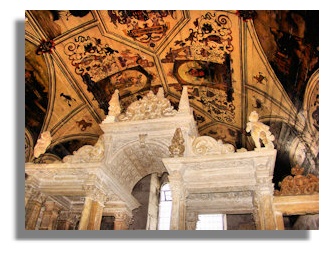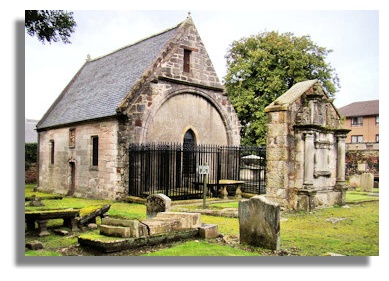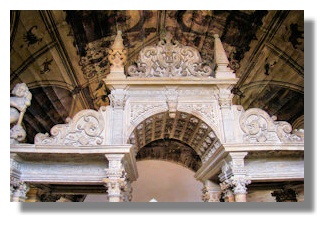Everlasting Love

Largs, on the Ayrshire coast, overlooking the Firth of Clyde and the island of Cumbrae, is still a popular destination for day-trippers from Glasgow and other parts of central Scotland. But few of those who wander along the promenade or pop into Nardini's famous ice cream parlour manage to find the side street which leads to the Skelmorlie Aisle. Which is a pity, since this is a gem of Renaissance architecture which is unique in Scotland. It has an elaborate carved stone tomb in Italian-baroque style with a painted timber ceiling above, showing lively scenes illustrating the seasons. It was built in 1636 as a shrine by a Scottish knight to keep alive the memory of his wife Dame Margaret Montgomerie who had been killed in a riding accident a few years earlier. Sir Robert Montgomerie was the 7th baron of Skelmorlie (a village a few miles along the coast from Largs where Sir Robert had his castle).
Robert Montgomerie, the 7th laird, was knighted by King James VI and then in 1628 was created a baronet by King Charles I. He was the son of another Robert; his mother was Dorothy, daughter of Lord Sempill. This Sir Robert married Margaret, daughter of Sir William Douglas of Drumlanrig. (The family crests of these ancestors are incorporated in a panel of the painted barrel ceiling in the Aisle). Margaret was a famous beauty and the subject of ballads written during her lifetime.
In his early years, Sir Robert had been notorious for his ferocious pursuit of the feud with the neighbouring Cunningham family (his lands had earlier belonged to the Cunninghams). But the death of his wife after 36 years of marriage convinced him that he should do penance by constructing the magnificent canopied tomb to her memory and regularly praying at the memorial. The mausoleum, made of Italian marble, adjoined the existing chapel in Largs. Internally, the building housing the tomb is just 29 feet long by 16 feet 6 inches wide.
Sir Robert is said to have travelled at night the five miles from his castle at Skelmorlie to pray at midnight in the tomb below the ornate monument where the body of his dead wife lay in a lead casket. A story is told of a local warlock bringing the Devil along with him to do a mischief to Sir Robert. However the laird was deep in prayer as usual and the Devil was forced to give up on his evil intent! When Sir Robert died, he joined his wife in the burial vault in another lead casket. Later, Margaret's presence was said to haunt Skelmorlie Castle. Another casket joined the husband and wife, said to be holding the remains of his ancestor, Sir Hugh Montgomerie of Eaglesham who had been killed around 250 years earlier at the Battle of Otterburn in 1388.
Largs Parish Church

The mausoleum was built as an extension to the original parish church in Largs in 1636, lying at right angles to the side of the main building. That old kirk first appears on record as far back as 1263. When the main part of the old church was demolished in 1802 following the construction of a replacement parish church nearby, the communicating arch was built up and this aisle or burial place was left to stand on its own. It has remained like that ever since as a monument to Sir Robert Montgomerie's devotion. One of the graves in the burial ground surrounding the mausoleum is of Sir Thomas Makdougall Brisbane, who in 1821 was the Governor of New South Wales, Australia and gave his name to the River and City of Brisbane in Australia.
The Tomb

The Renaissance canopied tomb of undressed Italian marble stands above the burial-vault entrance. It is 18 feet high, reaching almost to the timbered ceiling and 11½ feet long and 5 feet broad. It is regarded as one of the most ancient and ornate in Scotland. Sir Robert would kneel, praying, in the tomb below the monument where his wife's leaded burial casket lay. There is a verse in Latin carved on a panel of the monument giving a brief outline of Margaret Montgomerie's life. In translation reads:
For twice ten years and four a maid,
For thirty-six, a wedded wife,
Twice did Lucina bring her aid,
And two fair children blest my life.The image of his sire, my boy
Survives the hope of all our race,
But death, commissioned to destroy,
My daughter tore from my embrace.Of gentle soul and gentle birth,
And clad in beauty fair to see,
Loved by my God and lived on earth,
God now is all in all to me.The Painted Ceiling
The painted barrel vaulted timber ceiling is in vernacular style, with lively scenes in 41 sections illustrating the seasons along with the Montgomerie coat of arms and monogram, texts from the Scriptures, several views of the castle at Skelmorlie and signs of the Zodiac. The main panels were painted by an artist named J. S Stalker in 1638.
The springtime scene (pictured here) depicts people ploughing and preparing the soil for seed, figures fishing on the riverbank and horsemen and dogs chasing a stag and a hind. The panel illustrating summer shows sheep-shearing and hay cutting and stacking. There is a representation of the Aisle and the original church in this section. The Autumn panel shows barrels apparently filled with grain and the Swan Inn (it has a sign of a swan above the entrance) and other thatched buildings. Winter shows a frozen river and people skating on it.
One panel depicts the figure of a lady in long robes with a cape thrown back from her shoulders as she admires the antics of a prancing stallion. This may represent Lady Margaret Montgomerie herself?
There is also a heraldic panel bearing four Coats of Arms within a large diamond painted frame representing the houses of Drumlanrig, Lochinvar, Eglinton and Sempill, ancestral lines of Sir Robert and Lady Margaret.
Other panels (drawn to a higher standard than the four seasons) depict biblical stories such as Adam and Eve, with various symbolical items such as rings (for eternity) and a peacock (for vanity).
There are more photos of the mausoleum and the timbered ceiling in a Windows Media Slide Show. If you have any problems viewing this in your browser it is also available on YouTube.
Access
The Skelmorlie Aisle is located at the end of Manse Court, off Main Street in Largs. See the Location Map on Google. The key for access to the building is obtained from Largs Museum close by. The museum is open to the public 2 - 5pm Mondays to Sundays inclusive, from the last week in May until the North Ayrshire Open Day on the first Sunday in September.



